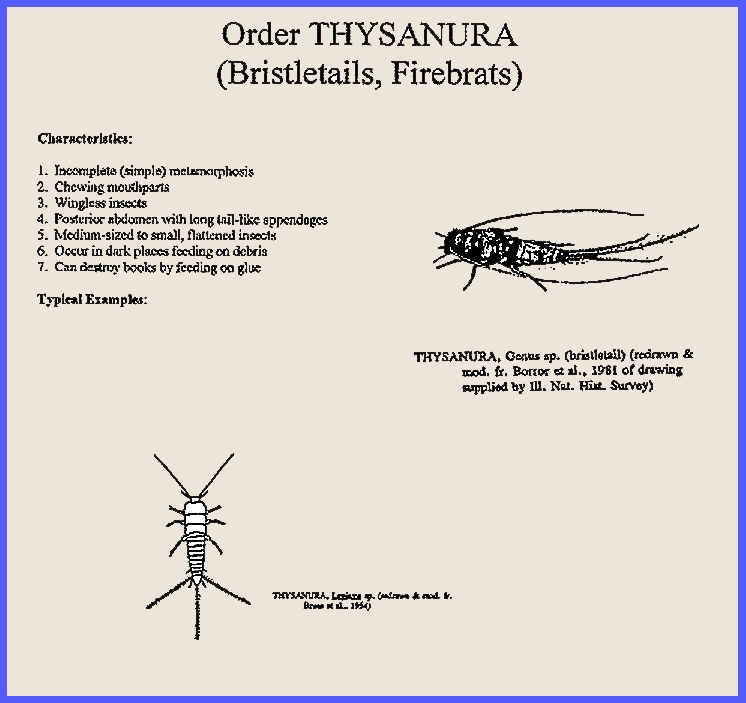File:
<thysanura.htm> < (Entomology),
(Invertebrates), (General
Index)> <Invertebrate Bibliography> <Glossary> <Site Description> < Home>
|
Entomology: THYSANURA 1 Kingdom: Animalia, Phylum: Arthropoda Subphylum: Hexapoda: Class: Insecta: Order: Thysanura (Contact) Please CLICK on underlined
categories to view and on included illustrations to enlarge: Depress
Ctrl/F to search for subject matter:
The Apteragota presently contains only one order, Thysanura -- <Adults> &
<Juveniles> --, while the
Protura, Diplura and Collembola have been moved to a separate class Entognatha. The Thysanura are known as silverfish,
bristletails
and firebrats. There are over 310 species of these tiny
insects known worldwide. The name
"silverfish" comes from the fact that they are covered with scales
that cast a silvery hue and from their undulating movements. The name "firebrat" refers to
different species that congregate around ovens and are often called "little oven
birds. These prefer high
temperatures of 98-deg. Fahrenheit. Their
mating habits are peculiar. The males drop a spermatophore during a
"mating
dance." The female
then picks up the spermatophore from the substrate.
Molting. -- These insects may
molt more than 41 times. After the
8th molt the sexes are distinguishable.
Molting continues after the eggs are laid, which occurs after the 36th
molt. Longevity. -- Their longevity is
about three years. Legs. -- Their legs are
modified to withstand surfaces with high temperatures. Their tarsi are "heat
resistant." However, they are
handicapped by not being able to cling to smooth surfaces. They also are fast runners and the only Insect
order with a remnant of abdominal legs. Economic Importance.
-- Thysanura are able to digest rayon and other wood products, just as are
the Isoptera (termites). Mostly they
consume dead organic matter, such as materials that
contain starch, e.g., books, bindings, and wallpaper paste.). ------------------------------------------- Details
of Insect Taxonomic Groups Examples of beneficial species
occur in almost every insect order, and considerable information on
morphology and habits has been assembled.
Therefore, the principal groups of insect parasitoids and predators
provide details that refer to the entire class Insecta. These details are available at <taxnames.htm>. ============== |
